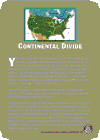|
|
In Oak
Park there is a ridge which runs just
west of Ridgeland Avenue through Taylor park, to near
Scoville Park, and then west to Downtown Oak Park. This
ridge, called the "Oak Park Spit" is an ancient
beach. The beach was formed in glacial times, 12,000
years ago, when the whole area to the east and north was
covered with ancient Lake Chicago. The lake was formed by
the melting glaciers. The outlet to the north was blocked
by ice and the lake rose until it found a point where it
could flow over the low divide and into the valley of the
Des Plaines and Illinois Rivers 1. |
 |
Ancient Lake Chicago
(12,000 years ago) |
The terrain in our Village is so flat that
the slopes are difficult to perceive. The best place to
see a distinct drop off in both directions is at the
northwest corner of Taylor Park, at the intersection of
Berkshire and Elmwood. There you will be standing on the
continental divide. At the time this area was first
settled, the land east of Oak Park, being an old lake
bottom, was mostly swamp. Our low ridge was the first
high land west of the Lake and was a desirable place to
build. Thus Oak Park's first settler, Joseph
Kettlestrings, in 1837 chose to
build west of Oak Park Avenue, on top of the ridge. The
oak trees, growing on the sandy ridge, gave Oak Park its
name 2.The fact of the divide is more than a mere
geographical curiosity. Along the entire length of the
divide, there is a point just five miles south of Oak
Park which provides the most desirable point of
crossing.3 Here, near Summit, and near the Village of
Lyons, the low height of the divide and the short
distance between streams on either side made it
relatively easy to portage canoes from one water system
to the other, facilitating travel from the east coast to
the Mississippi River. Thus an important trade route was
established, the very reason for founding a city here.
|



